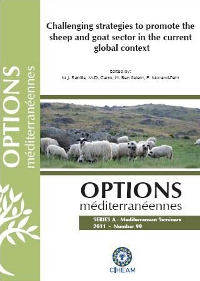| Article précédent | p. 233-237 | Article suivant |
Water intake of dairy goats in intensive systems
Data on water intake of dairy goats are scarce, especially in temperate climates. The aim of this work was to update previous results concerning the factors of variation of water intake linked to the level of intake (DMI), to composition of the diet or milk production. A data base was built with 505 records obtained during digestibility trials on 140 lactating goats receiving one of the 48 different diets differing for their chemical composition (percentage NDF = 45.0 ± 8.7; percentage CP = 17.7 ± 3.1) or their composition in ingredients (percentage hay = 26.7 ± 31.1). Total water intake (TWI) was directly proportional to DMI (3.32 l/kg) as well as to the water drunk (2.49 l/kg). There was a substitution between water drunk and water taken in with the feed. Dietary crude protein content and percentage of hay are positively correlated to the ratio TWI/DMI, but the dietary NDF content was not correlated with this ratio. These data pointed out the ability of goats kept in temperate climates to use water more efficiently than other ruminants: low TWI/DMI ratio and total substitution between water taken in with the feed and water drunk.
Les données concernant les facteurs de variation des ingestions d'eau par des chèvres laitières, en particulier sous des climats tempérés, sont rares. L'objet de ce travail était d'actualiser des résultats sur ce thème en faisant varier le niveau d'ingestion (MSI), la composition de la ration ou la production laitière. Une base de données a été constituée avec 505 mesures obtenues lors d'expériences de digestibilité, sur 140 chèvres recevant l'un des 48 régimes qui différaient par leur composition chimique ((pourcentage NDF = 45,0 ± 8,7; pourcentage MAT = 17,7 ± 3,1) ou leur composition en ingrédients (pourcentage foin = 26,7 ± 31,1). La quantité d'eau ingérée (Eau) est directement proportionnelle à celle de MSI (3,32 l/kg), comme la quantité d'eau bue (2,49 l/kg). Il y a eu substitution entre les quantités d'eau apportée par la ration et bue. Le ratio eau/MSI a augmenté avec les pourcentages de MAT ou de foin, mais n'a pas été corrélé avec le pourcentage NDF. Ces résultats ont montré la capacité de la chèvre élevée en milieu tempéré à mieux valoriser l'eau que les autres ruminants : ratio eau/MSI faible et substitution totale entre eau apportée par la ration et eau bue.
- [ Afficher ]
- [ Télécharger ]
- [ Exporter la citation ]
Vous pouvez télécharger la citation au format :
- [ Imprimer ]
-
Mots-clés
CHEVRE, EAU, INTENSIFICATION, PRISE ALIMENTAIRE (ANIMAUX), REGIME ALIMENTAIRECiter cet article
Giger-Reverdin S., Morand-Fehr P., Sauvant D. Water intake of dairy goats in intensive systems. In : Ranilla M.J. (ed.), Carro M.D. (ed.), Ben Salem H. (ed.), Morand-Fehr P. (ed.). Challenging strategies to promote the sheep and goat sector in the current global context. Zaragoza : CIHEAM / CSIC / Universidad de León / FAO, 2011. p. 233-237. (Options Méditerranéennes : Série A. Séminaires Méditerranéens; n. 99). 13. International Seminar of the Sub-Network on Nutrition of the FAO-CIHEAM Inter-Regional Cooperative Research and Development Network on Sheep and Goats, 2009/10/14-16, León (Spain). http://om.ciheam.org/om/pdf/a99/00801562.pdf



